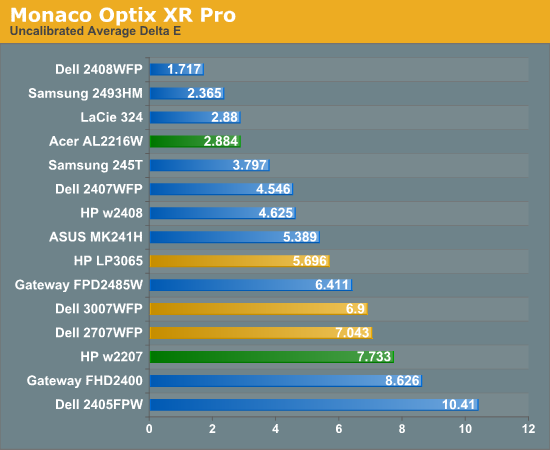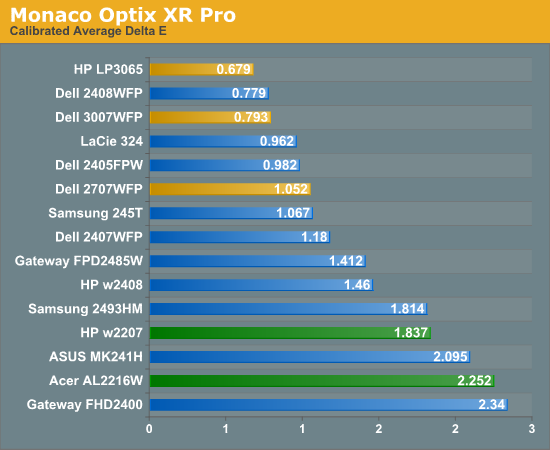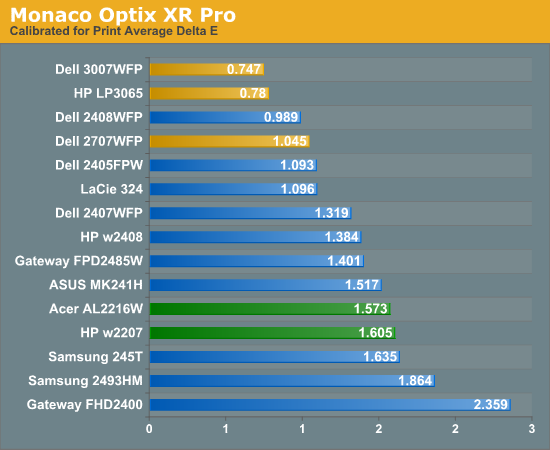Color Accuracy
Imaging professionals definitely like to have accurate colors, and the best way of assuring that your display shows the proper colors is to use a colorimeter and calibration software. However, not everyone has access to such tools and many users are unwilling to spend over $200, so we test before and after calibration. (Put more accurately, we calibrate the monitors and then tweak the created profile back to an uncalibrated state so that we can evaluate the performance of the display in its default state.) For calibration, we target a white level of 250 nits -- anything more than that is too bright in our opinion. We also do a second calibration targeting a white level of 100 nits, which would be useful when working on material that will end up in print form. Before we get the results, here are the display settings we used on the test LCDs. We let the LCDs stabilized for at least one hour before performing measurements.
| LCD Brightness and Contrast Settings | ||
| Standard Calibrated (~250 nits) | Calibrated for Print (~100 nits) | |
| ASUS MK241H | 45 Brightness, 80 Contrast 100-100-100 RGB |
50 Brightness, 80 Contrast 54-51-73 RGB |
| Dell 2408WFP | 50 Brightness, 50 Contrast 80-80-80 RGB |
48 Brightness, 50 Contrast 55-55-55 RGB |
| Gateway FHD2400 | 70 Brightness, 70 Contrast 76-77-92 RGB |
50 Brightness, 50 Contrast 57-57-70 RGB |
| LaCie 324 | 35 Brightness, 0 Contrast 128-128-128 RGB 2.2 Gamma, 6500K |
7 Brightness, 0 Contrast 128-128-128 RGB 2.2 Gamma, 6500K |
| Samsung 2493HM | 60 Brightness, 75 Contrast 100-100-100 RGB |
28 Brightness, 75 Contrast 46-37-65 RGB |



Starting with the uncalibrated results, it's pretty easy to see why we feel calibration tools are necessary for most users. This is not to say that you can't be happy with inaccurate colors -- your eyes will compensate, and some people prefer warmer (redder) or cooler (bluer) tones. However, if you're doing work with images or video as an example, it is important that what you see on your display matches as much as possible what others will see on their displays. Of the tested LCDs, only four are able to achieve an average Delta E of less than 3.0 without calibration -- three of which happen are part of this roundup. That's encouraging, as it indicates LCD manufacturers may be spending a bit of extra time to ensure that at least one of the settings will provide neutral, accurate colors. The real shocker however is the Dell 2408WFP. Its uncalibrated Delta E reaches an exceptional 1.7 -- a score that's better than several of the LCDs after calibration!
With calibration, all the scores improve substantially, but anyone serious about color accuracy is probably going to want an average Delta E of around 1.0 or less after calibration. Of the tested monitors, the 24" Dell displays (all three models that we've tested), the LaCie 324, and the two 30" LCDs all manage to accomplish this, along with the Dell 2707WFP and Samsung 245T. Switching to appropriate "printing" settings puts the three largest LCDs at the top of the charts, along with the Dell 2408WFP (and the old 2405FPW) and LaCie 324.
Most of the LCDs in this roundup place in the middle or upper portion of the above graphs, with one exception. The Gateway FHD2400 comes in last or in second to last in all three tests. We actually really like the Gateway display for many of its features, but in terms of color accuracy it is definitely lacking. We spent a substantial amount of time trying to tweak the settings in order to achieve better results, all to no avail. There's more to LCDs than color accuracy, of course, and the price and appearance might be enough to help you overlook the relatively poor performance here.










89 Comments
View All Comments
AnnonymousCoward - Friday, May 16, 2008 - link
I agree with Jarred on both accounts: you can't go wrong with the LP3065 or 3007WFP-HC, and input lag is far less than the lag time you experienced on the tablet. But if you're really sensitive to it, I'd avoid the Dell 2708, Dell 3008, Samsung 244T, and Samsung 245T, as those seem to have the worst lag of all.For unbeatable 24" color accuracy, the choice is obvious: NEC LCD2490WUXi (U.S.) or Hazro HZ24W (U.K.). I think they have mid-range lag (35ms?), which you probably wouldn't notice. The LP3065, 3007, and DoubleSight 26" are high quality IPS screens with very little lag, and for professional animation work, why not go bigger than 24"?
AnnonymousCoward - Sunday, May 11, 2008 - link
Jarred, I'm glad to see input lag drawing so much attention. You seem well aware of this, but I wanted to point out that the LP3065 was a poor choice for a reference monitor. It likely performs the same as the 3007-HC, which has measurements that bounce from 0-20ms; 3 increments on your scale (maybe 2 considering refresh rate). Some LCDs out there consistently measure close to 0ms.The editor's comments are completely out of context! ("They're huge, heavy, and require more power, and the best ones were made over five years ago. Sorry - LCDs are where everything is heading.") A heavy, power hungry, old, and obsolete 15" CRT would still be an ideal reference.
JarredWalton - Tuesday, May 13, 2008 - link
It would probably be a faster reference, but I'm not going to try to dig one up. Sorry. My place is crowded enough without keeping around an obsolete CRT. I sold off a couple 19" CRTs two years ago, and that was the last time I had one around for testing. I had to junk my old 21" CRT (from 1997) because I couldn't even give it away. 85 pounds now at the junk pile.As it stands, I will continue to use the LP3065 as a reference LCD. If I test an LCD that scores better than the LP3065, that's not a problem: it will have a negative "relative input lag" score. A CRT might very well score 20ms faster; my problem isn't with 0ms vs. 20ms (assuming CRTs can score 0ms); it's with 0ms vs. 60ms and perhaps 0ms vs. 40ms.
Personally, I'm certainly fine with the LP3065 - it is in use on my own gaming system and I've never been bothered with any discernible input lag. Image tearing caused by turning off VSYNC is a much bigger concern -- and that's one area where I'd like to see LCDs improve; a 120Hz refresh rate would help a lot. But then we'd need all new graphics cards and connectors to manage the data rates for 120Hz at 2560x1600.
AnnonymousCoward - Friday, May 16, 2008 - link
I hear ya on CRTs being too big to keep around :)I thought your measurements would have more variation, like by 40ms, since in many lag tests I've seen, measurements varied by 20ms. But your variations were 20ms, including both the reference and the one tested. I'd have to agree that a CRT isn't necessary, since the variations are under control (but I'll still add 11ms to the final numbers, as you've talked about). I'm surprised your 245T results weren't higher.
I have a 3007-HC and agree about the excessive tearing. And of course if the framerate can't stay above 60, I have to disable vsync and live with it. You gotta admit, it's quite nice that the 8800-series cards came out within a year of the 30"ers, and that those two separate technologies complement each other.
I wonder why the DoubleSight is going EOL, if it's such a great monitor and hot seller! Does that indicate customer return problems?
ShocWave - Wednesday, May 7, 2008 - link
Actually, I have a 2493HM.AV mode will display 720p and 1080p at the correct aspect ratio with overscan. What it basically does is fill the screen and crops out the sides.
It's not 1:1, but better then nothing.
JarredWalton - Wednesday, May 7, 2008 - link
I just don't understand why anyone would *want* overscan. AV Mode takes 720p stretched to fill the whole screen and then overscans it, right? Or are you saying it only crops the left and right sides? (I suppose I could check if I dig the LCD back out.)I'm not a stickler on aspect ratios, especially 16:9 stretched to fit 16:10 - the information is merely listed for those who really do care. I still think the Gateway has a better approach and overall better design. The Samsung however offers better color accuracy and a non-glossy panel for the same price. It's a close second in the TN panel contest (out of tested LCDs).
10e - Saturday, May 10, 2008 - link
Yes, that's exactly what it does. Takes the 720p/1080p image and "zooms" it so that it fills the screen vertically, but gets cut off at the sides. So you have a 16:10 "window" looking at a 16:9 screen that is missing some of the image left and right (about 5%)I use an image from the "TigerDave" site that shows exactly the amount of 720p and 1080p overscan a display will suffer. It does actually cut off a very small part of the image top and bottom as well.
I don't know what Samsung had in mind here. The newer revisions of the 245T and 275TPlus have a built in image setting for 16:9 now that supposedly works, so why they couldn't fix this in a technically newer design (2493HM) is confusing.
BattleRattle - Wednesday, May 7, 2008 - link
Do input lag against a CRT... Its the analog of the CRT that mattersviperboy2025 - Tuesday, May 6, 2008 - link
How does this compare to other reputable LCD monitors, I can't help but think anandtech is commercializing Dell displays. I mean how about the profesional serious from viewsonic, VP2650wb. They don't have a 24" oddly, but they do have a 26", VP2650wb, at a similar price as the dell 24", costing $615 at onsale.com with free shipping at the moment.The specs of this monitor seem to be better at everything than the dell, as it has 26" (compare to 24"), same resolution, 3ms response time, same 110% color gamut, 4000:1 contrast ration (compare to 3000:1), only difference I see are the inputs, since the professional serious doesn't carry TV inputs. But viewsonic does has a line of the X serious, all of which have hdmi, component, composite, and s video components, which i even doubt most people would use anyways since they would be attaching this to a computer not using it as a TV.
JarredWalton - Tuesday, May 6, 2008 - link
Drop contrast ratio and response time from that list, as they are meaningless figures. Color accuracy with "dynamic contrast" is horrible on all the displays I've tested - you can see the screen get darker/brighter as you watch, and I find it extremely distracting. So what you end up with is a 26" display at a good price. Is it better or worse than the Dell? In color accuracy, I'd bet a lot of money that it's worse without calibration.For the record, Dell displays are already "commercialized". The only thing wrong with the 2408WFP that I can see is input lag. I made this quite clear. If you're looking for a good 24" LCD for professional work, I'd recommend it without reservation. If you want a gaming LCD, probably look around more.
I can't review every LCD out there, in part because most companies don't send us samples. Viewsonic is one of those companies (I've emailed them at least six times in the past year without a single response). They can call something a "professional display" if they want, but that doesn't make it any more true than the "get rich quick" schemes you see floating around. It may or may not be a great LCD; I'd love to get one sent here for review. Note also that all it took was one email to LaCie and they jumped at the opportunity for this review. If you're looking for a true professional display and you want great support, I'd recommend them in a heartbeat. $300 more is a tough pill to swallow for casual use, but for professionals that should be a non-issue.